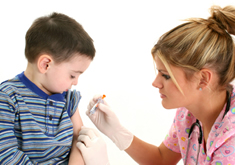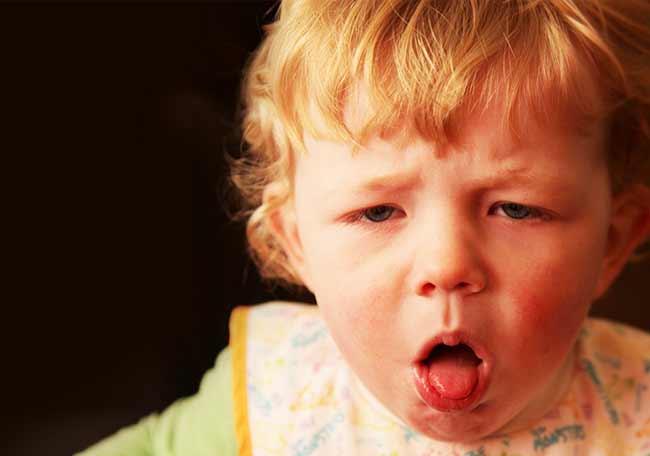Estrategias para disminuir la transmisión de pertussis a los niños

1. Gabutti G, Azzari C, Bonanni P, et al.Pertussis: current perspectives on epidemiology and prevention. Hum Vaccin Immunother. 2014; 11(1):108–117
2. Juretzko P, von Kries R, Hermann M, Wirsing von König CH, Weil J, Giani G. Effectiveness of acellular pertussis vaccine assessed by hospital based active surveillance in Germany. Clin Infect Dis. 2002; 35(2):162–167
3. Quinn HE, Snelling TL, Macartney KK, McIntyre PB. Duration of protection after first dose of acellular pertussis vaccine in infants. Pediatrics. 2014; 133(3). Available at: www.pediatrics.org/cgi/
content/full/133/3/e513
4. Campbell H, Amirthalingam G, Andrews N, et al. Accelerating control of pertussis in England and Wales. Emerg Infect Dis. 2012; 18(1):38–47
5. Briand V, Bonmarin I, Lévy-Bruhl D. Study of the risk factors for severe childhood pertussis based on hospital surveillance data. Vaccine. 2007; 25(41):7224–7232
6. Heininger U, Weibel D, Richard JL. Prospective nationwide surveillance of hospitalizations due to pertussis in children, 2006-2010 [published online ahead of print September 23, 2013]. Pediatr Infect Dis J.
7. Winter K, Harriman K, Zipprich J, et al. California pertussis epidemic, 2010. J Pediatr. 2012; 161(6):1091–1096
8. CDC. Pertussis outbreak trends. Available at: www.cdc.gov/pertussis/outbreaks/trends.html. Accessed August 22, 2014
9. Public Health England (PHE). Public Health England (PHE) enhanced pertussis surveillance. Available at:http://webarchive.nationalarchives.gov.uk/20140714084352/http:/www.hpa.org.uk/ hpr/archives/2013/news0513. htm#prtsss. Accessed March 25, 2015
10. CDC. Updated recommendations for use of tetanus toxoid, reduced diphtheria toxoid and acellular pertussis vaccine (Tdap) in pregnant women and persons who have or anticipate having close contact with an infant aged ,12 months—Advisory Committee on Immunization Practices (ACIP), 2011. MMWR Morb Mortal Wkly Rep. 2011; 60(41):1424–1426
11. Public Health England (PHE). Vaccination against pertussis (whooping cough) for pregnant women—2014. Available at: https://www.gov.uk/government/uploads/system/uploads/attachment_
data/file/338567/PHE_pertussis_in_pregnancy_information_for_HP_2014_doc_V3.pdf. Accessed August 22, 2014
12. Dabrera G, Amirthalingam G, Andrews N, et al. A case-control study to estimate the effectiveness of maternal pertussis vaccination in protecting newborn infants in England and Wales, 2012-2013. Clin Infect Dis. 2015; 60(3):333–337
13. CDC. Updated recommendations for use of tetanus toxoid, reduced diphtheria toxoid, and acellular pertussis vaccine (Tdap) in pregnant women—Advisory Committee on Immunization Practices (ACIP), 2012. MMWR Morb Mortal Wkly Rep. 2013; 62(7):131–135
14. Tomovici A, Barreto L, Zickler P, et al. Humoral immunity 10 years after booster immunization with an adolescent and adult formulation combined tetanus, diphtheria, and 5- component acellular pertussis vaccine. Vaccine. 2012; 30(16):2647–2653
15. Weston W, Messier M, Friedland LR, Wu X, Howe B. Persistence of antibodies 3 years after booster vaccination of adults with combined acellular pertussis, diphtheria and tetanus toxoids vaccine. Vaccine. 2011; 29(47):8483–8486
16. Healy CM, Rench MA, Baker CJ. Importance of timing of maternal combined tetanus, diphtheria, and acellular pertussis (Tdap) immunization and protection of young infants. Clin
Infect Dis. 2013; 56(4):539–544
17. Englund JA. The influence of maternal immunization on infant immune responses. J Comp Pathol. 2007; 137 (suppl 1):S16–S19
18. Gall SA, Myers J, Pichichero M. Maternal immunization with tetanus-diphtheria-pertussis vaccine: effect on maternal and neonatal serum antibody levels. Am J Obstet Gynecol. 2011; 204(4):e1–e5
19. Leuridan E, Hens N, Peeters N, de Witte L, Van der Meeren O, Van Damme P. Effect of a prepregnancy pertussis booster dose on maternal antibody titers in young infants. Pediatr Infect Dis J. 2011; 30(7):608–610
20. Van Savage J, Decker MD, Edwards KM, Sell SH, Karzon DT. Natural history of pertussis antibody in the infant and effect on vaccine response. J Infect Dis. 1990; 161(3):487–492
21. Healy CM, Rench MA, Edwards KM, Baker CJ. Pertussis serostatus among neonates born to Hispanic women. Clin Infect Dis. 2006; 42(10):1439–1442
22. Munoz FM, Bond NH, Maccato M, et al. Safety and immunogenicity of tetanus diphtheria and acellular pertussis (Tdap) immunization during pregnancy in mothers and infants: a randomized clinical trial. JAMA. 2014; 311(17): 1760–1769
23. Heininger U, Riffelmann M, Bär G, Rudin C, von König CH. The protective role of maternally derived antibodies against Bordetella pertussis in young infants. Pediatr Infect Dis J. 2013; 32(6):695–698
24. Heininger U, Riffelmann M, Leineweber B, Wirsing von Koenig CH. Maternally derived antibodies against Bordetella pertussis antigens pertussis toxin and filamentous hemagglutinin in preterm and full term newborns. Pediatr Infect Dis J. 2009; 28(5):443–445
25. Amirthalingam G, Andrews N, Campbell H, et al. Effectiveness of maternal pertussis vaccination in England: an observational study. Lancet. 2014; 384(9953):1521–1528
26. Cherry JD. Tetanus-diphtheria-pertussis immunization in pregnant women and the prevention of pertussis in young infants. Clin Infect Dis. 2015; 60(3): 338–340
27. Housey M, Zhang F, Miller C, et al; CDC. Vaccination with tetanus, diphtheria, and acellular pertussis vaccine of pregnant women enrolled in Medicaid—Michigan, 2011-2013. MMWR Morb Mortal Wkly Rep. 2014; 63(38):839–842
28. Goldfarb IT, Little S, Brown J, Riley LE. Use of the combined tetanus-diphtheria and pertussis vaccine during pregnancy. Am J Obstet Gynecol. 2014; 211(3):e1–e5
29. Healy CM, Baker CJ. Prospects for prevention of childhood infections by maternal immunization. Curr Opin Infect Dis. 2006; 19(3):271–276
30. Donegan K, King B, Bryan P. Safety of pertussis vaccination in pregnant women in UK: observational study. BMJ. 2014; 349(Jul 11):g4219
31. Kharbanda EO, Vazquez-Benitez G, Lipkind HS, et al. Evaluation of the association of maternal pertussis vaccination with obstetric events and birth outcomes. JAMA. 2014; 312(18):1897–1904
32. Englund JA, Anderson EL, Reed GF, et al. The effect of maternal antibody on the serologic response and the incidence of adverse reactions after primary immunization with acellular and wholecell pertussis vaccines combined with diphtheria and tetanus toxoids. Pediatrics. 1995; 96(3 pt 2):580–584
33. Hardy-Fairbanks AJ, Pan SJ, Decker MD, et al. Immune responses in infants whose mothers received Tdap vaccine during pregnancy. Pediatr Infect Dis J. 2013; 32(11):1257–1260
34. Beel ER, Rench MA, Montesinos DP, Mayes B, Healy CM. Knowledge and attitudes of postpartum women toward immunization during pregnancy and the peripartum period. Hum Vaccin
Immunother. 2013; 9(9):1926–1931
35. Wiley KE, Massey PD, Cooper SC, Wood N, Quinn HE, Leask J. Pregnant women’s intention to take up a post-partum pertussis vaccine, and their willingness to take up the vaccine while pregnant: a cross sectional survey. Vaccine. 2013; 31(37):3972–3978
36. Schellekens J, von König CH, Gardner P. Pertussis sources of infection and routes of transmission in the vaccination era. Pediatr Infect Dis J. 2005; 24(5 Suppl):S19–S24
37. Bosdure E, Raymond J, Cosnes-Lambe C, et al. Systematic family screening in case of infant pertussis [in French]. Med Mal Infect. 2008; 38(9):477–482
38. de Greeff SC, Mooi FR, Westerhof A, et al. Pertussis disease burden in the household: how to protect young infants. Clin Infect Dis. 2010; 50(10):1339–1345
39. Wendelboe AM, Njamkepo E, Bourillon A, et al; Infant Pertussis Study Group. Transmission of Bordetella pertussis to young infants. Pediatr Infect Dis J. 2007; 26(4):293–299
40. Halperin BA, Morris A, MackinnonCameron D, et al. Kinetics of the antibody response to tetanus-diphtheria-acellular pertussis vaccine in women of childbearing age and postpartum women. Clin Infect Dis. 2011; 53(9):885–892
41. Healy CM, Rench MA, Baker CJ. Implementation of cocooning against pertussis in a high-risk population. Clin Infect Dis. 2011; 52(2):157–162
42. Castagnini LA, Healy CM, Rench MA, Wootton SH, Munoz FM, Baker CJ. Impact of maternal postpartum tetanus and diphtheria toxoids and acellular pertussis immunization on infant pertussis infection. Clin Infect Dis. 2012; 54(1):78–84
43. Quinn HE, Snelling TL, Habig A, Chiu C, Spokes PJ, McIntyre PB. Parental Tdap boosters and infant pertussis: a casecontrol study. Pediatrics. 2014; 134(4). Available at: www.pediatrics.org/cgi/
content/full/134/4/e713
44. Lim GH, Deeks SL, Crowcroft NS. A cocoon immunisation strategy against pertussis for infants: does it make sense for Ontario? Euro Surveill. 2014; 19(5):20688
45. Meregaglia M, Ferrara L, Melegaro A, Demicheli V. Parent “cocoon” immunization to prevent pertussisrelated hospitalization in infants: the case of Piemonte in Italy. Vaccine. 2013; 31(8):1135–1137
46. Skowronski DM, Janjua NZ, Tsafack EP, Ouakki M, Hoang L, De Serres G. The number needed to vaccinate to prevent infant pertussis hospitalization and death through parent cocoon immunization. Clin Infect Dis. 2012; 54(3):318–327
47. Van Rie A, Hethcote HW. Adolescent and adult pertussis vaccination: computer simulations of five new strategies. Vaccine. 2004; 22(23-24):3154–3165
48. Coudeville L, Van Rie A, Getsios D, Caro JJ, Crépey P, Nguyen VH. Adult vaccination strategies for the control of pertussis in the United States: an economic evaluation including the dynamic population effects. PLoS ONE. 2009; 4(7):e6284
49. Westra TA, de Vries R, Tamminga JJ, Sauboin CJ, Postma MJ. Cost effectiveness analysis of various pertussis vaccination strategies primarily aimed at protecting infants in
the Netherlands. Clin Ther. 2010; 32(8):1479–1495
50. Rossmann Beel E, Rench MA, Montesinos DP, Healy CM. Acceptability of immunization in adult contacts of infants: possibility of expanding platforms to increase adult vaccine uptake. Vaccine. 2014; 32(22):2540–2545
51. Rosenblum E, McBane S, Wang W, Sawyer M. Protecting newborns by immunizing family members in a hospital-based vaccine clinic: a successful Tdap cocooning program during the 2010
California pertussis epidemic. Public Health Rep. 2014; 129(3):245–251
52. Walter EB, Allred N, Rowe-West B, Chmielewski K, Kretsinger K, Dolor RJ. Cocooning infants: Tdap immunization for new parents in the pediatric office. Acad Pediatr. 2009; 9(5):344–347
53. Dylag AM, Shah SI. Administration of tetanus, diphtheria, and acellular pertussis vaccine to parents of high-risk infants in the neonatal intensive care unit. Pediatrics. 2008; 122(3). Available at:
www.pediatrics.org/cgi/content/full/122/3/e550
54. Simonetti A, Martini I, Bonomo G, et al. Improving adherence rates to a cocooning program: a pilot experience in Italy. Hum Vaccin Immunother. 2013; 9(5):1142–1145
55. Urwyler P, Heininger U. Protecting newborns from pertussis: the challenge of complete cocooning. BMC Infect Dis. 2014; 14(Jul 17):397
56. Terranella A, Asay GR, Messonnier ML, Clark TA, Liang JL. Pregnancy dose Tdap and postpartum cocooning to prevent infant pertussis: a decision analysis. Pediatrics. 2013; 131(6). Available at: www.pediatrics.org/cgi/content/full/131/6/e1748
Comentarios
Para ver los comentarios de sus colegas o para expresar su opinión debe ingresar con su cuenta de IntraMed.








